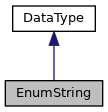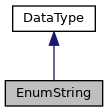The EnumString data type class represents a string. More...


Static Public Member Functions | |
| _.Library.String | DisplayToLogical (_, _.Library.String val) |
| Converts the input value val, which is a string, into the logical string format. More... | |
| _.Library.Status | IsValid (_, _.Library.RawString val) |
| Tests if the logical value val, which is a string, is valid. More... | |
| _.Library.String | LogicalToDisplay (_, _.Library.String val) |
| Converts the value of val, which is in logical format, into a display string. More... | |
| _.Library.String | LogicalToOdbc (_, _.Library.String val) |
| Converts the value of val, which is in logical format, into a display string. More... | |
| _.Library.String | Normalize (_, _.Library.RawString val) |
| Truncates value val to MAXLEN, characters. | |
| _.Library.String | OdbcToLogical (_, _.Library.String val) |
| Converts the input value val, which is a string, into the logical string format. More... | |
Static Public Attributes | |
| COLLATION = None | |
| The EnumString data type class represents a string. More... | |
| CONTENT = None | |
| XML element content "MIXED" for mixed="true" and "STRING" or "ESCAPE" for mixed="false". More... | |
| DISPLAYLIST = None | |
| Used for enumerated (multiple-choice) attributes. More... | |
| ESCAPE = None | |
| Controls the translate table used to escape content when CONTENT="MIXED" is specified. | |
| JSONTYPE = None | |
| JSONTYPE is JSON type used for this datatype. | |
| MAXLEN = None | |
| The maximum number of characters the string can contain. | |
| MINLEN = None | |
| The minimum number of characters the string can contain. | |
| PATTERN = None | |
| A pattern which the string should match. More... | |
| TRUNCATE = None | |
| Determines whether to truncate the string to MAXLEN characters. | |
| VALUELIST = None | |
| Used for enumerated (multiple-choice) attributes. More... | |
| XSDTYPE = None | |
| Declares the XSD type used when projecting XML Schemas. | |
 Static Public Attributes inherited from DataType Static Public Attributes inherited from DataType | |
| INDEXNULLMARKER = None | |
| Override this parameter value to specify what value should be used as a null marker when a property of the type is used in a subscript of an index map. More... | |
The EnumString data type class represents a string.
This is a specialized type of String that allows you to define an enumerated set of possible values (using the DISPLAYLIST and VALUELIST parameters). Unlike the regular String class, the display values for this property are used when columns of this type are queried via ODBC.
The logical value of the EnumString data type is a string.
|
static |
Converts the input value val, which is a string, into the logical string format.
Returns the logical value of the input string val.
|
static |
|
static |
Converts the value of val, which is in logical format, into a display string.
Removes all the null characters from the string.
Returns the string value of val.
|
static |
Converts the value of val, which is in logical format, into a display string.
Converts VALUELIST entries to their cooresponding DISPLAYLIST value.
Returns the string value of val.
|
static |
Converts the input value val, which is a string, into the logical string format.
Converts DISPLAYLIST entries to their cooresponding VALUELIST value. If there is no entry specified for the given value in the DISPLAYLIST, the input value is returned.
If this input value does not match a value in the VALUELIST a validation error will probably be returned upon filing or saving.
Returns the logical value of the input string val.
|
static |
The EnumString data type class represents a string.
This is a specialized type of String that allows you to define an enumerated set of possible values (using the DISPLAYLIST and VALUELIST parameters). Unlike the regular String class, the display values for this property are used when columns of this type are queried via ODBC.
The logical value of the EnumString data type is a string.
The default collation value used for this data type.
Note that if you specify a truncation length and also a <parameter>VALUELIST</parameter> then your truncation length must be longer or equal to your longest VALUELIST value
|
static |
XML element content "MIXED" for mixed="true" and "STRING" or "ESCAPE" for mixed="false".
If CONTENT="STRING" (default) XML special characters are put in a CDATA section during XML export. If CONTENT="ESCAPE" XML special characters are escaped during XML export. If CONTENT="ESCAPE-C14N" XML special characters are escaped during XML export using the translate table, XMLC, specified for XML Canonicalizaton. The main difference is that CR is escaped as
|
static |
Used for enumerated (multiple-choice) attributes.
Used in conjunction with the VALUELIST parameter for enumerated (multiple-choice) attributes. DISPLAYLIST, if not null, represents the display values for the attribute corresponding with the logical values listed in VALUELIST.
The display values are returned by the LogicalToDisplay method.
|
static |
A pattern which the string should match.
The value of PATTERN should be a valid ObjectScript pattern match expression.
|
static |
Used for enumerated (multiple-choice) attributes.
VALUELIST is either a null string ("") or a delimiter separated list (where the delimiter is the first character) of logical values. If a non-null value is present, then the attribute is restricted to values in the list, and the validation code simply checks to see if the value is in the list.